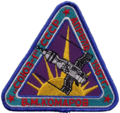Template:Selected anniversaries/April 24: Difference between revisions
Jump to navigation
Jump to search
No edit summary |
No edit summary Tag: Manual revert |
||
| (14 intermediate revisions by the same user not shown) | |||
| Line 1: | Line 1: | ||
<gallery> | <gallery> | ||
File:Thomas Fincke.jpg|link=Thomas Fincke (nonfiction)|1656: Mathematician and physicist [[Thomas Fincke (nonfiction)|Thomas Fincke]] dies. He introduced the modern names of the trigonometric functions tangent and secant. | File:Thomas Fincke.jpg|link=Thomas Fincke (nonfiction)|1656: Mathematician and physicist [[Thomas Fincke (nonfiction)|Thomas Fincke]] dies. He introduced the modern names of the trigonometric functions tangent and secant. | ||
File:Franck Hertz Hg tube.jpg|link=Franck–Hertz experiment (nonfiction)|1914: The [[Franck–Hertz experiment (nonfiction)|Franck–Hertz experiment]], a pillar of quantum mechanics, is presented to the German Physical Society. | File:Franck Hertz Hg tube.jpg|link=Franck–Hertz experiment (nonfiction)|1914: The [[Franck–Hertz experiment (nonfiction)|Franck–Hertz experiment]], a pillar of quantum mechanics, is presented to the German Physical Society. | ||
File:Soyuz 1 patch.png|link=Soyuz 1 (nonfiction)|1967: Cosmonaut Vladimir Komarov dies in [[Soyuz 1 (nonfiction)|Soyuz 1]] when its parachute fails to open. He is the first human to die during a space mission. | File:Soyuz 1 patch.png|link=Soyuz 1 (nonfiction)|1967: Cosmonaut Vladimir Komarov dies in [[Soyuz 1 (nonfiction)|Soyuz 1]] when its parachute fails to open. He is the first human to die during a space mission. | ||
</gallery> | |||
{{Template:Categories: April 24}} | |||
Latest revision as of 07:30, 1 May 2024
1656: Mathematician and physicist Thomas Fincke dies. He introduced the modern names of the trigonometric functions tangent and secant.
1914: The Franck–Hertz experiment, a pillar of quantum mechanics, is presented to the German Physical Society.
1967: Cosmonaut Vladimir Komarov dies in Soyuz 1 when its parachute fails to open. He is the first human to die during a space mission.


